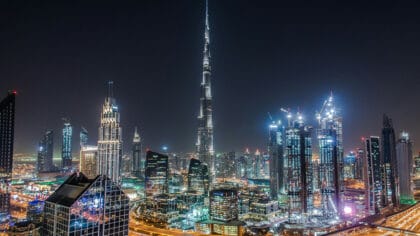Road travel is a high carbon way to travel. Building every mile of road creates 3,500 tons of CO2… and that’s before a single vehicle has driven on it! But that’s changing fast.
The future is a zero carbon one, powered by renewable electricity, hydrogen and biofuels. We also need to consider integrated multi-modal transport – not just relying on cars but convenient public transport.
Embed from Getty ImagesTo meet the challenge of reducing CO2 emissions, designers and engineers are having to think about more than just the vehicles that use the roads – and this is leading to some exciting new technology.
1) E-Motorways
We’ve all heard of motorways but what about E-Motorways?
Sweden has plans to build the world’s first electrified motorway, allowing electric cars to charge themselves as they drive along.
A major benefit would be eliminating having to locate and wait at charging stations.
But how do you charge a moving vehicle?
Options include a catenary system using overhead wires and an inductive system which buries equipment under the road surface sending power to coils fitted to each car.
Embed from Getty Images2) Integrated travel
Multi-modal integrated travel is innovation to reduce emissions.
It sounds complicated but is really simple.
Take a journey from the countryside to city centre.
A computer app arranges the journey in the most efficient way using a series of steps and types of transport.
So instead of one long car journey, travellers switch from car to public transport along the route and complete their journey by walking or cycling.
Embed from Getty Images3) Street lights
It’s not just the roads and vehicles on those roads that generate emissions.
Have think about the streetlights, road sign lights and traffic lights, all consume huge amounts of energy… and contribute to light pollution.
This isn’t great for those living near roads, human or wildlife!
Using LEDs and directional lighting can help to reduce the amount of energy used, cutting emissions.
Embed from Getty Images4) Light alternatives
Thinking about lights on major roads, an innovative alternative could be light-emitting lines painted along the roadway.
They would absorb sunlight by day and release it as a glow at night, guiding drivers who may otherwise rely on overhead lights.
And if there’s not be much sunlight, one could use kinetic energy, produced by cars as they travel across special panels on the road surface.
Embed from Getty Images5) Trees and bushes
Another way to go green is to-well-go green!
Roadside verges are home to large amounts of plant and wildlife.
Managing and developing these habitats is not only good for biodiversity but can actually make a difference to carbon emissions because trees and other plant life absorb and store carbon.
And where trees can shade the direct sunlight, that can help keep surface temperatures lower, helping ensure they don’t melt.
Embed from Getty ImagesLet’s time travel to the year 2050…
Newsflash!
You no longer need to travel to Brazil to get a taste of the jungle – just take a trip on the motorway. New rainforest roads feature covered biomes, with constant temperatures and humidity that help the lush vegetation of the tropical regions to grow.
Of course, you’ll be lovely and cool in your driverless car so you can relax and enjoy the scenery whilst the rich biome does its bit to absorb emissions and help us maintain carbon zero!
…aaaand we’re back in 2023.
Embed from Getty ImagesNow THAT would make a long journey more interesting! As you can see, by thinking about the whole picture of road travel – not just the vehicles we use, but the roads and vegetation alongside them, we can make changes to meet the challenges of carbon emissions.
You could be part of the change. We want you to use your imagination and think about how else we could change our roads to reduce emissions.
Tell us your ideas about how YOU would build a better road in the future for your chance to win.
Have a go at our Road to 2050 Word Search!

Created with support from Rees Jeffreys Road Fund.
Add a commentRoad to 2050
Find out more about why roads are built and how they help us get around the country.
More From Road to 2050






